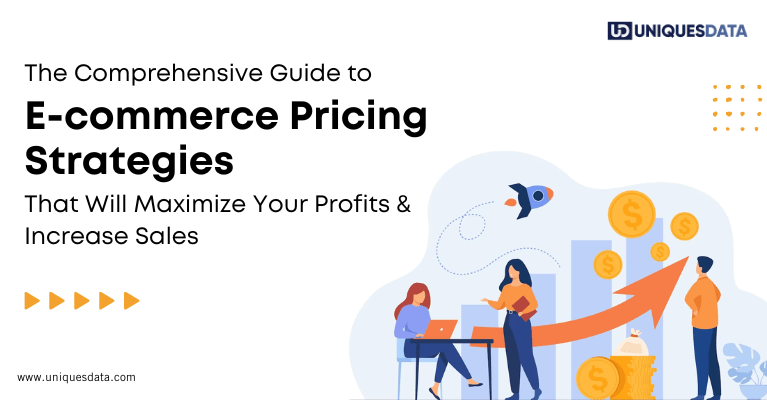As an online retailer, one of your biggest challenges is setting the right pricing strategy. Pricing your products too high may turn customers away, while pricing them too low may leave you with little profit. So, how do you find the perfect balance?
eCommerce pricing strategies can make or break a business. Finding a pricing strategy that maximizes profit while being competitive in the market. With the right approach, you can determine the optimal prices of your products and services to draw in more customers.
This guide will provide an overview of the pricing strategies available and how to implement them for maximum profit with minimum effort. It will also discuss price analysis tools to help you make informed decisions about your eCommerce pricing strategy.
In this blog, we’ll explore some eCommerce pricing strategies that can help you increase sales and maximize profit.

Why Your Business Needs a Dynamic Pricing Strategy
According to HubSpot, the best pricing strategy is a model or method to establish the best price for a product or service. It helps businesses select prices to maximize profits and shareholder value while considering consumer and market demand.
But to be clear, there is no one size fits all eCommerce pricing model that applies to all businesses. Each operation has different traits and characteristics, so companies must experiment with various strategies to find the best for them.
An optimized approach considers a company’s revenue goals, marketing objectives, target audience, brand positioning, and product attributes. External factors like consumer demand, competitor pricing, and overall market and economic trends will also influence it.
However, there is a delicate balance between pricing products high enough to maximize returns and low enough to attract buyers and meet customer expectations.
6 eCommerce Pricing Strategies to Help Increase Sales and Maximize Profits
The eCommerce pricing strategies that will help you increase sales and maximize profits are:
- Price skimming
- Price bundling
- Penetration pricing
- Competitor pricing
- Value-based pricing
- Psychological pricing

1. Price Skimming Strategies to Maximize Initial Revenue
The price skimming is an eCommerce pricing strategy that focuses on delivering a few high-end products while creating a halo effect that makes consumers hungry for new experiences.
Price skimming may be the winning tactic if you sell a unique or inventive product. Making a hurry encourages people to determine whether or not to purchase things.
It entails setting a higher price and dropping it as additional competitors arise with a similar product. Furthermore, firms offer a disc discounts the next 24 hours to encourage customers to add things to their shopping carts swiftly.
Companies sometimes promote their high-priced products as limited or special editions to instill consumer anxiety about losing out. When competition is low, businesses can drive revenue while maintaining lower pricing.
2. Price Bundling Strategies to Boost Average Order Value
Bundle pricing is a strategy that effectively increases e-commerce sales and draws customers into a shop. It entails assembling related products and offering them as a package deal.
Bundle pricing is a multiple-pricing technique in which many products are sold at a discounted price. It works well for raising sales volume and decreasing inventory. Consumers are more likely to buy a bundle of products than individual items, which promotes cross-selling and upselling.
For instance, Jeans cost $20, sunglasses cost $5, and trendy shoes cost $15. Customers would be glad to save $10 when buying three goods together if the company produces a bundle of these items and offers it for $30. This strategy also works well if the company wishes to eliminate its inventory or sell its leftovers.
3. Penetration Pricing Strategies to Increase Market Share
Unlike price skimming, penetration pricing works best when a brand enters a competitive marketplace.
You’ll want to set your prices low to start and raise them later. This is also where discount codes and strategies can play a critical role in winning over new customers to help develop brand awareness.
The danger of penetration pricing is that it may damage your brand’s reputation or cause consumers to undervalue your products or perceive them as low-quality.
4. Competitor pricing
The method for choosing the best strategic prices to best take advantage of a product or service-based market compared to rivals is known as competitive pricing.
This pricing approach is more commonly used by businesses selling identical products because services change from business to business, but product qualities remain consistent. To set a price based on a competitor-based approach, a company needs to conduct some research and keep a watch on the pricing established by its competitors for the same product it is selling.
A company has to consistently follow the pricing set by its competitors for the same product it sells. For example, if an eCommerce company sells garments, it must research the pricing online established by its competitors.
Competitor pricing is done by making a list of the different prices set by the competitors. After that, make a note of the lowest and highest prices. Find the average of the highest and lowest prices. It will tell you how much your products are worth.
Many newcomers need to pay more attention to pricing their products below the average. Do not make this error! It will deprive you of a healthy profit and make it challenging for your company to cover its operational and marketing costs.

5. Value-based pricing
Value-based pricing is a pricing approach that determines prices primarily on the consumer’s perceived value of a product or service.
It is customer-focused, which means that firms base their pricing on what the customer believes a product is worth. It frequently generates more significant markups and is more profitable, making it ideal for growing businesses with long-term ambitions.
Value-based pricing works well for companies with distinguishing characteristics, such as sustainability. It is helpful in markets where possessing a product boosts a customer’s self-image or allows for unrivaled life experiences.
Its perceived value reflects the worth customers are willing to assign to an item and directly impacts the consumer’s price. Artists, vehicle manufacturers, amusement parks, and social media influencers frequently use value-based pricing to market products and services.
Businesses use value-based pricing after evaluating the key aspects listed below, depending on their goals or the state of their industry.
- The market influences how much a consumer will pay for a thing.
- The value impacts the value of an effect provided to the customer.
- Competitors’ pricing can influence how valuable customers believe a product to be.
Nonetheless, extensive market research and analysis are required. The value-based pricing principle is an important concept that can be used to determine the price of a product.
6. Psychological Pricing Strategy
Psychological pricing is a strategy that uses psychology or the subconscious to convince the customer to spend more money. It entails setting prices less than a whole number, such as $3.99.
It is known as Charm pricing, an 1880s pricing strategy that includes setting prices just below a round figure. According to studies, prices ending in odd digits have much greater conversion rates.
Bracketing is a psychological pricing technique used to persuade a buyer to choose a given option at a specific price. The idea here is based on extreme aversion, which refers to the human tendency to reject powerful possibilities in favor of moderate ones.
You offer three alternatives to help buyers find the goods they want: a lower-quality alternative, a midrange option, and a premium choice. The trick is to provide the cheaper choice at a low price and the more expensive option at a much higher price.
Another example of psychological pricing is Decoy pricing, shifting preferences between two options in response to a third option that abnormally favors one of the first two. For example, pizza place sells two sizes of pizza, a small choice for $3 and a large one for $7, a large number of customers will choose the trim option.
But, if a medium alternative is released for $6.50, buyers would choose the large bucket because they believe they are getting a significant increase for only $0.50. This is referred to as a “decoy.”
Innumeracy is a strategy that removes fractions and percentages from promoting sale items, available discounts, and other offers. It takes advantage of consumers’ lack of motivation, inclination, and capacity to apply basic math ideas in everyday life. It is a simple and effective psychological pricing method that companies should adopt.
Psychological pricing approaches yield more significant returns with little effort or considerable price reductions. They can also streamline and improve clients’ shopping experiences by generating the appearance of a good deal.
A well-crafted psychological pricing strategy can also attract consumer attention by establishing a solid perception of value and informing the world that you are providing one.

Conclusion
Lastly, setting the correct eCommerce cost structure is critical for maximizing revenues and staying competitive in the ecommerce sector.
You can attract more customers while still earning a profit by using tactics such as dynamic pricing, bundle pricing, psychological pricing, subscription pricing, and price anchoring. To remain competitive, watch your competitors’ rates and alter yours accordingly.
Use the optimal eCommerce pricing strategy to produce a maximum profit with less work.
Kelly Anderson is the customer success manager for Edatamine, a renowned data management firm, recognized for providing the best quality customised solutions at Affordable rates. Kelly provides valuable insights concerning Web research Outsourcing services to boost the business growth of a global clientele.


